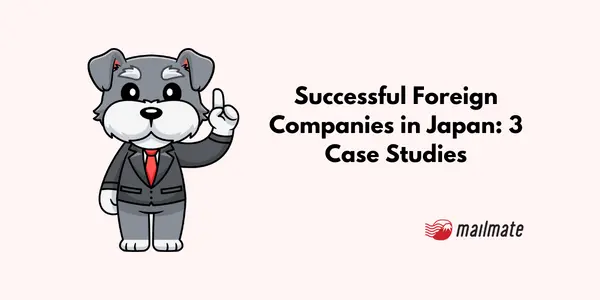Successful Foreign Companies in Japan: 3 Case Studies

What does an effective business strategy for Japan look like?
With notorious red tape to wade through and cultural pitfalls to navigate, foreign brands must be courageous, determined, and highly adaptable.
This article covers 3 case studies of successful foreign companies in Japan and the touted reasons for their success.
Note: we have no connection to the companies covered in this article, and our ranking is based on Japanese market perception of the foreign brands that have done well, as written about in Japan’s business news media.
Case Study #1. P&G Japan
Proctor & Gamble (P&G) was originally established in Cincinnati, Ohio, in 1837 by William Procter and James Gamble. In Japan, P&G is known for being one of the leading companies manufacturing daily life goods, as well as renowned for their skill at localizing marketing strategies.
「アリエール」「ボールド」「パンテーン」「ファブリーズ」「SK-II」「ジレット」「ブラウン」「パンパース」and countless more in Japan are all brands under P&G, many of which have achieved household recognition here in Japan.
However, their advertisement success has been the result of much adaptation and learning. In the early 1970s, P&G’s marketing campaign for pampers (diapers) failed miserably because the imagery used in their ads showed a stork delivering a baby—folklore that does not exist in Japan.

Image: Thunderbird School of Global Management, ASU
After this and similar failures in localization, they fully reversed their strategy. Today, P&G focuses on “having local experts be in charge of local enterprises,” according to P&G’s Asia Regional Brand Director Shinsuke Konoha in this CNET Japan article.
Thunderbird School of Global Management adds, “P&G’s willingness to learn, adapt and invest in Japan’s tough market was ultimately profitable.”
Further reasons for their success, according to Wada Hiroko, former vice president of P&G, include brand management and human resources training:
Wada on the importance of human resources training: “Daily operations and fostering human resources must be treated as equally important [as brand management]. I hear some say that they don’t have time for training newcomers as sales are dropping, but even at those times, training human resources must be viewed as equally important to other work.”
Key takeaway: P&G’s focus on fostering human resources and hiring local experts helped to firmly localize this global brand to one that is appealing to the Japanese consumer.
Case Study #2. Japan Coca-Cola K.K.
The Coca-Cola Company was incorporated in 1892 in Atlanta, Georgia, and came to Japan in 1957. Many experts state that its success here has been due to its ability to customize its strategy for Japan.
For the most part, Japanese do not drink as much coke as the average American. Because of that, Japan Coca-Cola K.K. has developed original products like “Soukenbicha” and “Aquarius,” which have been a major hit locally.
Naturally, there are pitfalls to customizing and developing original products per country—mainly to do with costs and the lack of a shared identity across country borders.
This issue is part of a larger ongoing marketing debate regarding how much brands should deviate from the original when customizing their strategies per country.
It’s a complex issue with no clear answers, but Coca-Cola Japan tentatively stepped out to develop Remondo, a chuhai, which is a popular alcoholic beverage featuring shochu or vodka and carbonated water.

Image: Nikkei.com
Despite initial doubts by business strategists, sales of Remondo soared.
Japan Coca-Cola K.K.’s Remondo still has a ways to go to achieve as much success as the senpais of chuhai, Santory or Kirin, but the results were sizable enough to catch the attention of Coca-Cola America, and in March 2021, Coca-Cola America released their own 4.7% alcoholic beverage.
Although the reviews of the new alcoholic beverage in America were a bit underwhelming, Japan’s strategy worked for its Japan market as chuhais do not require specialized brewing methods, and they were able to apply their existing skills of making softdrinks without too much expenditure on new equipment.
Another deciding factor was that Japan Coca-Cola K.K. successfully leveraged their brand name to attract enough news and social media attention to their move to alcoholic beverages and raised awareness of the new product before its release. On-point consumer segment targeting and pricing were also factors attributed to its success.
Key takeaways: Customizing strategies and creating original products that fit the country/market was key to success for Japan Coca-Cola K.K.
Case study #3. ZARA
Zara is a Spain-based fast fashion brand founded in 1975, entering the Japanese market in 1997. Zara owes its success to upholding its high quality, keeping the prices reasonable, and maintaining rapid turnaround.

Image. Zara in Shinjuku
According to Japan External Trade Organization (JETRO), Zara’s business model is a success story. “It takes less than 4 days for a shipment to reach Tokyo from the logistics center in La Coruña, and in addition, shipments are sent in exactly the amounts needed twice a week. Japanese customers account for the highest rate of repeat business among Zara clientele in all countries.”
Other points leading to Zara’s success in Japan have to do with its overall brand strategy, outlined by Martin Roll in “The Secret of Zara’s Success: A Culture of Customer Co-creation.”
“Zara empowers its sales associates and store managers to be at the forefront of customer research – they intently listen and note down customer comments, ideas for cuts, fabrics or a new line, and keenly observe new styles that its customers are wearing that have the potential to be converted into unique Zara styles.”
By some estimates, once Zara decides on a new design, it only takes 1 to 2 weeks for the new item of clothing to be out on the shelves.
While most retailers try to predict what will trend and plan production, Zara’s quick-paced supply chain enables the fast fashion giant to evolve with ever-shifting customer wishes.
Key takeaways: A sustainable and robust business model is a strategy that works regardless of trend changes.
Closing thoughts
It would be remiss not to mention the sizeable R&D and marketing budgets that played some role in the success these case study companies have enjoyed.
But when all other things are equal, a large budget alone is not a guarantee of success for foreign companies in Japan.
Key aspects for foreigners thinking of bringing their company to Japan to consider: adapting to the mindset of the Japanese consumer and their particular behaviors and buying patterns, along with developing and training local human resources.
Spending too long figuring out your Japanese mail?
Virtual mail + translation services start at 3800 per month. 30-day money-back guarantee.

